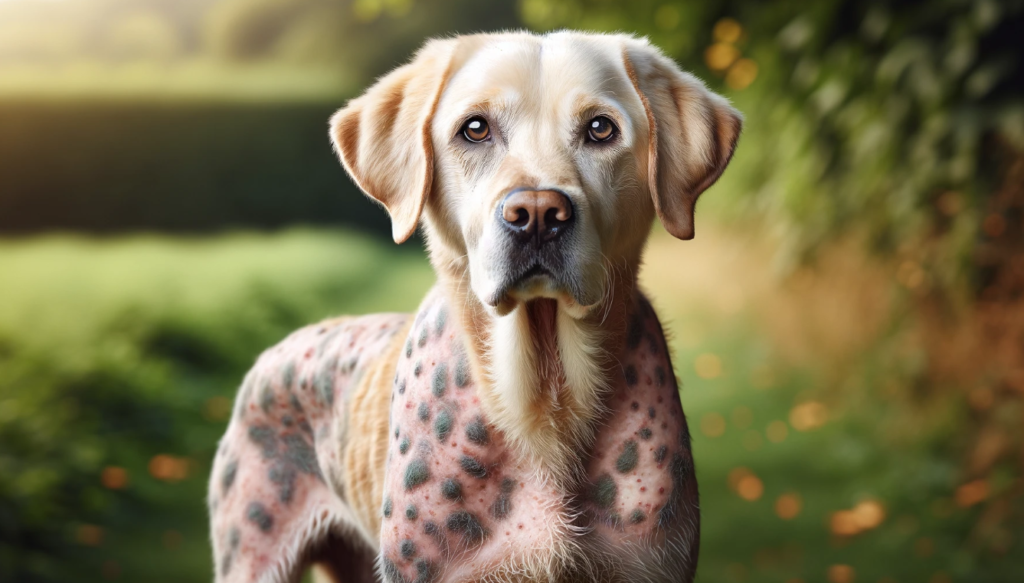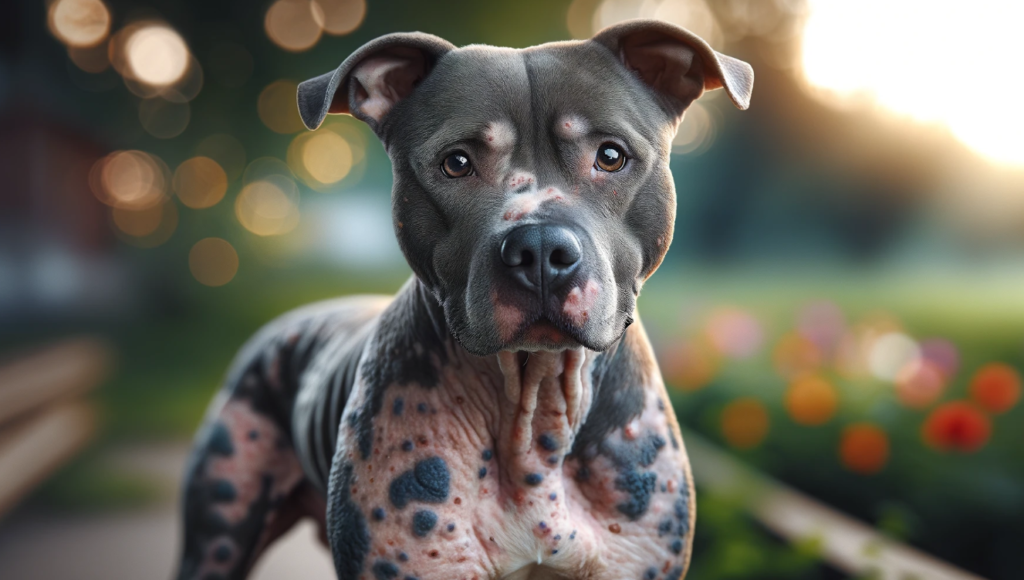As a holistic veterinarian, I understand how much you love your furry friend. Spotting the early symptoms of mange in dogs can be a real lifesaver. It’s a condition that’s often overlooked until it’s too late, causing unnecessary discomfort for your beloved pet. In this article, we’ll explore the early signs of mange, the different types, and how it impacts your dog’s health. We’ll also discuss diagnosis, treatment options, and preventative measures. Remember, the sooner you can identify and treat mange, the better the outcome for your four-legged companion. So, let’s begin this journey of understanding and tackling mange in dogs.

Being a responsible pet parent means always being on the lookout for any signs of discomfort or illness in your furry friend. One such condition that can cause significant distress in dogs is mange. Early detection of this condition can lead to more effective treatment, so let’s discuss the early symptoms of mange in dogs.
Identifying Early Signs of Mange in Dogs
The first signs of mange often resemble common skin issues, which can make early detection tricky. However, some symptoms tend to emerge sooner than others. These include:
- Intense itching and scratching
- Redness and inflammation of the skin
- Development of sores and lesions
- Hair loss, particularly in patches
- Dry, crusty skin
Remember, early detection is vital, so if your dog starts showing any of these signs, it’s time to consult with a vet.
Physical Changes Indicating Mange in Dogs
Mange doesn’t just affect your dog’s skin; it can also cause noticeable changes in their physical appearance. Dogs with mange often have a rough, dull coat due to hair loss. The skin may also appear thicker and wrinkled. These physical changes, combined with the discomfort caused by itching and scratching, can lead to changes in your dog’s behavior, such as restlessness or a lack of appetite.
It’s essential to remember that these symptoms can also be indicative of other health issues. Therefore, a proper veterinary diagnosis is crucial to ensure accurate treatment. Understanding the early symptoms of mange in dogs is the first step towards helping your furry friend lead a healthy and comfortable life.
If you notice any of these changes in your dog, don’t wait for the condition to worsen. Reach out to your vet immediately. After all, your dog’s health and happiness are worth more than anything.
Spotting Early Symptoms of Mange in Dogs
As a veterinarian, I understand how distressing it can be for dog parents when their furry friends are unwell. One common skin condition in dogs is mange, and being able to identify the early symptoms of mange in dogs can help ensure a quick and effective treatment.
There are two primary types of mange in dogs: Sarcoptic and Demodectic. Let’s delve into the early signs associated with each.
Sarcoptic Mange in Dogs
Sarcoptic mange, also known as canine scabies, is caused by the Sarcoptes scabiei mite. The early symptoms of this type of mange can include:
- Intense itching: Dogs with Sarcoptic mange will often scratch and bite at their skin incessantly.
- Redness and rash: Look out for red, inflamed skin or a rash, especially around the ears, elbows, and belly.
- Hair loss: Patchy hair loss is a common early sign of Sarcoptic mange.
Demodectic Mange in Dogs
Demodectic mange, or Demodex, is caused by a different type of mite that naturally exists on a dog’s skin but can cause problems when their population increases. The early symptoms of Demodectic mange can include:
- Localized hair loss: Unlike Sarcoptic mange, the hair loss with Demodectic mange is usually localized to specific areas.
- Mild itching: Some dogs with Demodectic mange may experience mild itching, but this is less common than with Sarcoptic mange.
- Scaly skin: You may notice your dog’s skin becoming scaly or crusty.
By understanding the early symptoms of mange in dogs, you can help your pet get the treatment they need as soon as possible. If you notice any of these symptoms, it’s important to consult with a veterinarian right away.
How Mange Affects Dogs
When we talk about how mange affects our beloved dogs, we’re not just referring to those early symptoms of mange in dogs like itching and hair loss. Mange can have a significant impact on a dog’s overall health and behavior.
Impact of Mange on Dog’s Health
Mange, caused by tiny mites burrowing into a dog’s skin, can lead to a host of health issues. The physical discomfort from the relentless itching and skin irritation can be quite severe. This constant scratching can lead to skin injuries, secondary bacterial or yeast infections, and even a compromised immune system.
Here are some health issues your fur baby may face:
- Severe Skin Infections: Scratching can lead to open sores, which can become infected if not treated promptly.
- Immune System Stress: The dog’s body will be in a constant state of high alert trying to fight off the mites, which can weaken the immune system over time.
- General Discomfort: Mange can cause discomfort, leading to changes in appetite and sleep patterns.
Behavioral Changes in Dogs with Mange
The physical discomfort caused by mange can also lead to noticeable changes in your dog’s behavior. Your once playful and energetic pup might become lethargic and less interested in activities they once enjoyed.
Here are some behavioral changes you might notice:
- Incessant Scratching: Your dog might scratch or bite their skin constantly in an attempt to relieve the itch.
- Changes in Temperament: Discomfort can make your dog irritable or anxious.
- Decreased Activity: Your dog might show less interest in physical activities like walks or play sessions due to discomfort or lethargy.
Watching your furry friend suffer through mange can be heart-wrenching. But remember, recognizing the early symptoms of mange in dogs is the first step towards getting them the treatment they need. So, stay vigilant, and don’t hesitate to consult your vet at the first sign of trouble.

Veterinary Tests for Mange in Dogs
When it comes to diagnosing mange in dogs, your vet will likely perform a series of tests to confirm the presence of mites. This may include:
- Skin Scraping Test: This is the most common test for diagnosing mange. Your vet will scrape a small area of your dog’s skin to collect samples. These samples are then examined under a microscope to detect mites.
- Hair Pluck Test: In some cases, your vet may pluck hairs from your dog’s coat to examine them for mites.
- Physical Examination: A thorough physical examination can also help identify signs of mange, such as redness, inflammation, and hair loss.
Confirming Mange in Dogs
While the above tests can help identify mange, a definitive diagnosis can sometimes be challenging. This is because mites can be difficult to find, especially in the case of sarcoptic mange. If your dog’s symptoms persist despite negative test results, your vet might still treat for mange based on the symptoms and their professional judgment.
It’s important to remember that early detection is key when it comes to mange. If you notice any changes in your dog’s behavior or physical appearance, such as excessive scratching, bald patches, or skin inflammation, it’s best to consult with a vet immediately.
Remember, mange is not just a cosmetic issue. Without proper treatment, it can lead to serious health problems. So, always keep an eye out for early symptoms of mange in dogs to ensure your furry friend stays happy and healthy.
And remember, as a responsible pet parent, it’s your job to ensure your dog gets the care they need. So, don’t hesitate to seek professional help if you suspect something is wrong. Your dog will thank you for it!
Treatment Options for Mange in Dogs
If your furry friend has been diagnosed with mange, don’t panic. There are several effective treatments available to help your dog overcome this condition. Let’s explore both medical treatments and home remedies for mange in dogs.
Medical Treatments for Mange in Dogs
Once your vet has confirmed the presence of mange, they’ll likely recommend a specific course of treatment based on the type of mange and your dog’s overall health. Here are some common medical treatments:
- Medicated Shampoos: These are often used to kill mites on the skin surface and soothe inflammation. They’re typically used in conjunction with other treatments.
- Topical Solutions: These are applied directly to the affected areas and are often used for localized demodectic mange.
- Oral Medications: These are usually prescribed for more severe or widespread cases. These medicines not only kill the mites but also help boost your dog’s immune system to prevent future infestations.
- Injectable Ivermectin: This is often used for cases of sarcoptic mange and is usually administered by your vet.
Home Remedies for Mange in Dogs
Alongside medical treatments, there are also several home remedies you can use to soothe your dog’s symptoms and speed up recovery. Always make sure to consult your vet before trying any home remedies. Here are a few options:
- Honey: Natural honey can be applied to affected areas to soothe inflammation and itchiness. It also has antimicrobial properties that can help kill mites.
- Apple Cider Vinegar: Diluted apple cider vinegar can be sprayed onto your dog’s skin to help restore its natural pH and fight off mites.
- Aloe Vera: Aloe vera is known for its soothing and healing properties. It can be applied to your dog’s skin to relieve itching and inflammation caused by mange.
Remember, every dog is unique and what works for one may not work for another. It’s important to keep a close eye on your dog’s condition and consult your vet regularly throughout the treatment process. With the right treatment plan and plenty of love and care, your furry friend will be back to their old self in no time.

Tips for Preventing Mange in Dogs
Preventing mange in dogs is crucial to maintain their overall health. It’s important to remember that mange is highly contagious, so it’s best to keep your dog away from infected animals. Here are some effective tips to prevent mange in dogs:
- Regular Bathing: Keeping your dog clean is essential. Regular bathing and grooming can help get rid of mites that cause mange.
- <strong>Healthy Diet: A strong immune system can help prevent mange. Ensure your dog is getting a balanced diet rich in vitamins and nutrients.
- Hygiene: Clean your dog’s bedding, toys, and bowls regularly. This will help remove any mites and prevent them from spreading.
- Vaccinations: Regular vaccinations can help protect your dog from various diseases, including mange.
Importance of Regular Check-ups for Mange Prevention
Regular veterinary check-ups are vital in detecting the early symptoms of mange in dogs. These check-ups can help in early diagnosis and treatment, preventing the condition from getting worse.
Vets can perform various tests to confirm the presence of mites that cause mange. These tests include skin scrapings, biopsies, and blood tests. If your vet detects mange mites, they can start treatment immediately to prevent the mites from spreading and causing severe damage.
Regular vet visits also provide an opportunity to discuss any concerns or changes you’ve noticed in your dog’s behavior or physical condition. Remember, early detection is crucial in managing mange and ensuring your dog’s swift recovery.
Preventing mange in dogs is not just about treating the condition, but also about maintaining a healthy and hygienic environment for your pet. Regular vet check-ups, a balanced diet, and good hygiene practices can go a long way in keeping your dog mange-free.
Recovery and Aftercare for Dogs with Mange
Post-Treatment Care for Dogs with Mange
After a successful treatment for mange, your furry friend will require some special care to ensure a full recovery. The first priority is maintaining a clean and comfortable environment to prevent a recurrence of the condition. Regularly wash your dog’s bedding and clean its living area to eliminate any remaining mites.
It’s also crucial to continue any prescribed medication until the end of the treatment period, even if your dog seems to have recovered. Stopping medication prematurely could lead to a resurgence of the mange. Regular vet check-ups are also important during this period to monitor your dog’s recovery and adjust treatment if necessary.
Long-Term Health Management for Dogs Recovered from Mange
Once your dog has recovered from mange, long-term health management is essential. Regular grooming can help detect any early symptoms of mange and prevent its return. This includes brushing their coat to remove dead skin and hair, which can harbor mites, and bathing them with a mild, hypoallergenic shampoo.
Remember, a healthy diet can boost your dog’s immune system and keep mange at bay. Nutrient-rich foods can help strengthen your dog’s skin barrier, making it harder for mites to cause an infection. Regular exercise is also important to keep your dog’s immune system strong.
Finally, your dog will need regular veterinary check-ups to ensure they remain mange-free. These visits are a chance to catch any potential health issues early, including a recurrence of mange.
Being a dog parent isn’t always easy, but it’s worth it when you see your furry friend happy and healthy. Remember, early detection of mange symptoms can make treatment easier and more effective, so always keep a watchful eye on your dog’s health. Together, you can beat mange and enjoy many more happy years together.
Frequently Asked Questions
1. What are the early signs of mange in dogs?
The early signs of mange in dogs can include intense itching, redness, sores, and hair loss. You may also notice changes in your dog’s behavior such as restlessness due to discomfort.
2. How quickly do symptoms of mange appear in dogs?
Symptoms of mange can appear as early as one week after exposure, but in some cases, it may take up to six weeks for signs to become apparent.
3. Can my dog get mange from another dog?
Yes, mange is highly contagious and can be easily transmitted from one dog to another through direct contact or shared bedding and grooming tools.
4. What should I do if I suspect my dog has mange?
If you suspect your dog has mange, it is important to seek veterinary care as soon as possible. Your vet can perform a skin scraping test to confirm the diagnosis and recommend appropriate treatment.
5. Can mange be prevented in dogs?
Preventing mange involves regular grooming, maintaining a clean environment, and avoiding contact with infected animals. Regular vet check-ups can also help detect and treat mange early.
